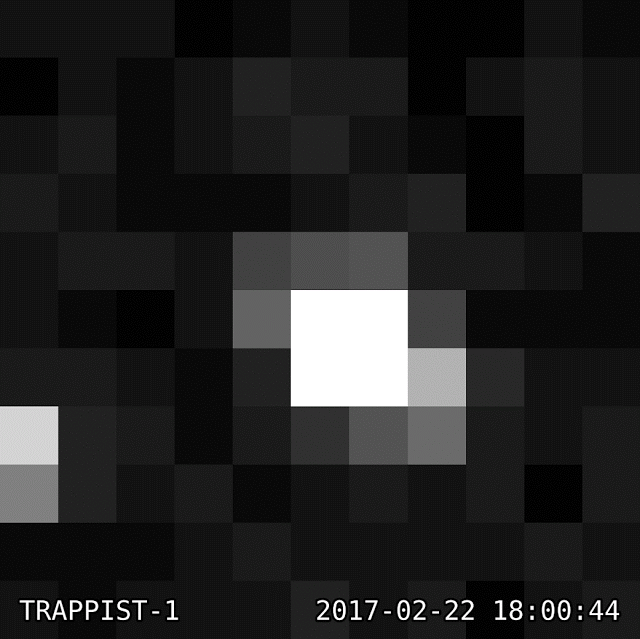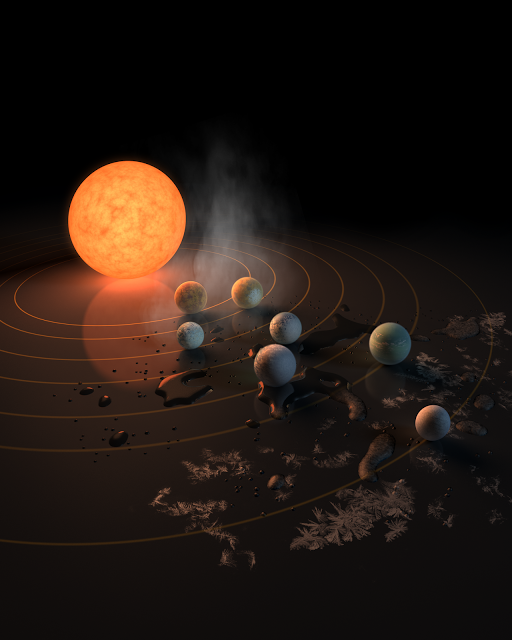

| Online: | |
| Visits: | |
| Stories: |

| Story Views | |
| Now: | |
| Last Hour: | |
| Last 24 Hours: | |
| Total: | |
NASA’s Kepler Provides Another Peek at Ultra-cool Neighbor With 7 Earth Sized Planets
During the period of Dec. 15, 2016 to March 4, the Kepler spacecraft, operating as the K2 mission, collected data on the star’s minuscule changes in brightness due to transiting planets. These additional observations are expected to allow astronomers to refine the previous measurements of six planets, pin down the orbital period and mass of the seventh and farthest planet, TRAPPIST-1h, and learn more about the magnetic activity of the host star.
The TRAPPIST-1 star, an ultra-cool dwarf, has seven Earth-size planets orbiting it. This artist’s concept appeared on the cover of the journal Nature on Feb. 23, 2017.
The release of the raw, uncalibrated data collected will aid astronomers in preparing proposals due this month to use telescopes on Earth next winter to further investigate TRAPPIST-1. By late May, the routine processing of the data will be completed and the fully calibrated data will be made available at the public archive.
The observation period, known as K2 Campaign 12, provides 74 days of monitoring. This is the longest, nearly continuous set of observations of TRAPPIST-1 yet, and provides researchers with an opportunity to further study the gravitational interaction between the seven planets, and search for planets that may remain undiscovered in the system.
The image depicts the location of TRAPPIST-1, an ultra-cool dwarf star home to seven Earth-size planets, in NASA’s Kepler spacecraft’s field of view. The call out box shows the amount of light detected by each pixel in a small section of Kepler’s onboard camera. The light collected from TRAPPIST-1 is visible at the center of the image. Not directly visible are the planets that orbit TRAPPIST-1.

Credits: NASA Ames/W. Stenzel
TRAPPIST-1 wasn’t always on the radar to study. In fact, the initial coordinates for the patch of sky defined as Campaign 12 were set in Oct. 2015. That was before the planets orbiting TRAPPIST-1 were known to exist, so Kepler would have just missed the region of space that is home to this newfound star system of interest.
Credits: NASA
“We were lucky that the K2 mission was able to observe TRAPPIST-1. The observing field for Campaign 12 was set when the discovery of the first planets orbiting TRAPPIST-1 was announced, and the science community had already submitted proposals for specific targets of interest in that field,” said Michael Haas, science office director for the Kepler and K2 missions at Ames. “The unexpected opportunity to further study the TRAPPIST-1 system was quickly recognized and the agility of the K2 team and science community prevailed once again.”
This 360-degree panorama depicts the surface of a newly detected planet, TRAPPIST 1-d, part of a seven planet system some 40 light years away. Explore this artist’s rendering of an alien world by moving the view using your mouse or your mobile device.
Credits: NASA
The added refinements to the previous measurements of the known planets and any additional planets that may be discovered in the K2 data will help astronomers plan for follow-up studies of the neighboring TRAPPIST-1 worlds using NASA’s upcoming James Webb Space Telescope.
During Campaign 12, a cosmic ray event reset the spacecraft’s onboard software causing a five-day break in science data collection. The benign event is the fourth occurrence of cosmic ray susceptibility since launch in March 2009. The spacecraft remains healthy and is operating nominally.

Kepler detects a change in brightness when a planet passes in front of a star from the vantage point of the telescope. Transiting planets block a tiny fraction of starlight that produces miniscule dips in the brightness of their host star. An Earth-size planet passing in front of a small ultra-cool dwarf star like TRAPPIST-1 creates less than a one percent dip in brightness, and is not visible with the naked eye.
Astronomers use sophisticated algorithms to search the data for these dips in brightness, and in particular, to correct for the spacecraft’s small movements in space—this is the ‘flickering’ of the pixels seen in the movie.
During the period of Dec. 15, 2016 and March 4, the Kepler spacecraft, operating as the K2 mission, observed TRAPPIST-1 for 74 days. This animation shows 60 brightness measurements or photos taken by Kepler’s onboard camera once a minute for an hour on February 22. Called a target pixel file, the image covers an area of 11 square pixels or 44 square arcseconds of the sky. This area is equivalent in size to holding up a grain of sand at arms length towards the sky.

Credit: NASA Ames/G. Barentsen
Michele Johnson, Ames Research Center, Moffett Field, Calif.
Elizabeth Landau, Jet Propulsion Laboratory,
Source:



